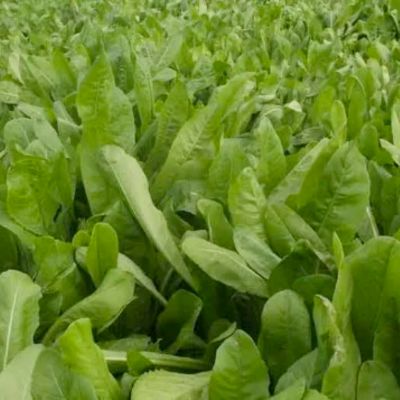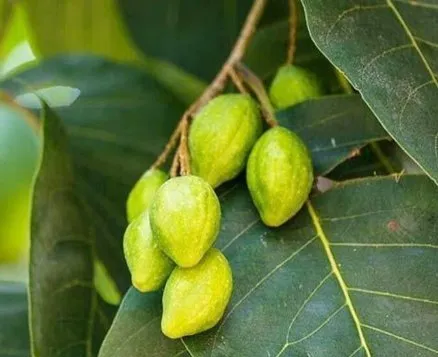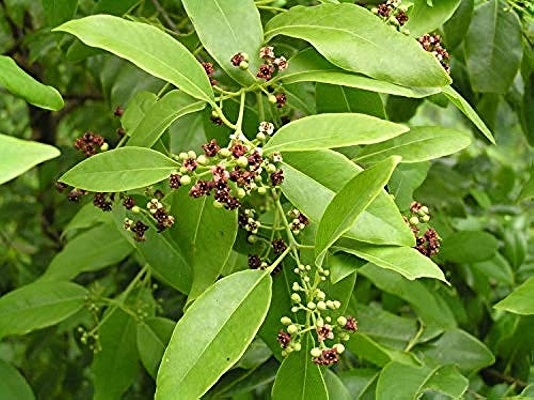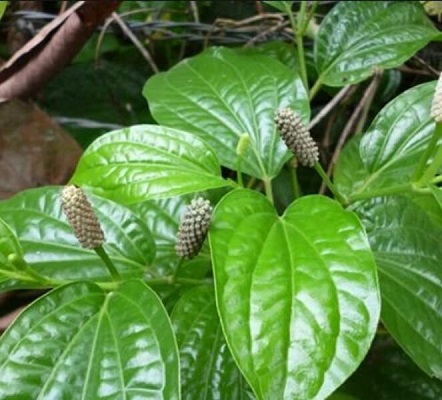On This Page
Haritaki – Terminalia chebula
Introduction
Haritaki, commonly known as ‘chebulicmyrobalan’ is one of most useful herbs in medicinal field. The name ‘haritaki’ itself means that the plant is very auspicious and can cure all diseases. Haritaki have vast therapeutic actions and is the most used herb in Ayurvedic treatments. The word Terminalia means proceeding from the extremity at the end.
Haritaki have numerous therapeutic properties. The plant can be used as antimicrobial, antifungal, antibacterial, antistress, antispasmodic, hypotensive, hypolipidemic, anthelmintic and purgative agent. Haritaki is used to treat diseases like Skin allergies, Diabetes mellitus, Hemorrhoid, Cough, Asthma, Fever etc. Dr. Gupta’s IAFA has experimentally proven many actions of Haritaki. The tannin contents from Haritaki can act as antidiabetic, renoprotective, antioxidant and hypotensive agent. The chebulic acid from the plant helps to alleviate ischemia also. The active principles of the plant have actions like antiinflammatory, immunomodulatory, and free radical scavenging. The chebulic acid from Haritaki is also found to be useful against type 2 Diabetes. The dried fruits of Haritaki contains tannin extracts which helps the plant to act as an antibacterial agent.
Action of Haritaki – Terminalia chebula in Allergies
Haritaki have many medicinal properties including antiallergic, antimicrobial and anti-inflammatory actions. The plant contains phytoconstituents like tannin, chebulic acid, chebulagic acid, chebulinic acid, gallic acid, sorbitol etc which aids in it’s antiallergic properties. The bark of Haritaki is used in Skin allergies (Kushta) caused by the vitiation of all three doshas,Vata Pitta and Kapha. The plant also have antimicrobial actions and anti-inflammatory actions which also helps in the speedy recovery of Skin Allergies caused by microbes.
Vernacular Names
| Sanskrit Name | Haritaki |
| Hindi Name | Harad |
| English Name | Chebulicmyrobalan |
| Malayalam Name | Kadukka |
| Kannada Name | Alalekayi |
| Marathi name | Hirada |
Botanical Name
Terminalia chebula
Family
Combretaceae
Morphology of Haritaki – Terminalia chebula
- Haritaki is a moderate to large sized deciduous tree
- The leaves are glabrous and of elliptic oblong shape
- Inflorescence are spike type usually in short panicles
- The flowers are hermaphrodite.
- Fruit is of pendulous drupe type
- Seeds are oblong and very thick
- Bark is dark brown with many vertical cracks
Ayurveda reference of Haritaki – Terminalia chebula

Geographical distribution of Haritaki – Terminalia chebula
Haritaki is found through out India. It is seen abundantly in forests of North India, Central provinces and in South India states like Tamil Nadu and Kerala.
Phytoconstituents of Haritaki – Terminalia chebula
The plant contains phytoconstituents like Tannins, chebulic acid, d-galloyl glucose, chebulagic acid, gallic acid, chebulinic acid, sorbitol, terchebin, ethyl gallate.
Parts used of Haritaki – Terminalia chebula
- Fruits
Dosage of Haritaki – Terminalia chebula
- Decoction(Kwatham)- 50-60 ml
- Powder(churna)- 2-4 g
Medicinal Properties of Haritaki – Terminalia chebula
- Shothahara – anti inflammatory
- Rasayana – Rejuvenative
- Medhya- promotes intelligence
- Swasahara- cures asthmatic conditions
- Varnya – increases complexion
- Pramehahara – cures diabetes
- Vranahara – useful in ulcers and wounds
- Kushtaghna – useful in skin diseases
- Krimighna – useful in worm disease
- Vishaghna – useful in poisoning
- Kasahara – cures Cough
- Sula hara- Relieves pain
- Chardigna- cures vomiting

Have A Health Issue?
Consult Online
- Dr. Sahil Gupta (B.A.M.S., M.H.A.)
Ayurvedic Allergy Specialist
CEO & Founder of IAFA®
Home remedies of Haritaki – Terminalia chebula
Haritaki is one of the most used herbs in Ayurvedic science . As it’s name indicates, it have wide variety of therapeutic actions when used alone and as well as in combinations. As it is easily available in houses, many remedies can be prepared by using Haritaki.
- In duodenal ulcer (parinamasula) – Haritaki seeds are taken and cleaned well. It is then crushed and taken along with jaggery and sugar.
- In Piles (Arsas) – Haritaki kept in Cow’s urine for overnight. It is then mixed with jaggery and is taken internally .
- In Vomiting (Chardi) – In case of Vomiting, Haritaki is powdered well and taken along with Honey.
- In constipation (vibadda) – Haritaki taken and powdered well. It is then taken along with Jaggery. Constipation will immediately relieved.
- In Excessive sweating (Atisweda)- The Haritaki fruits are taken and powdered well. It is then made into a paste and anointed on the body. Then taken bath.
- In Diabetes (Prameha) – Mixture of Haritaki, Gooseberry and Honey taken daily will help to keep Diabetes in control .
- In Inflammation (sotha) – Fruits of Haritaki powdered well and mixed with Sesamumindicum and applied on skin part.
- In Skin diseases (Kushta) – Paste of Haritaki is applied over skin. The paste have antiallergic property and can cure skin infections.
Dr.Gupta’s IAFA aims on the promotion of Ayurvedic science. The treatment measures taken by IAFA is strictly based on the methods mentioned in Ayurveda sources like Ashtanga Hrudaya. The herbs used by our system are collected naturally and are free from side effects. We maintains strict protocols to ensure the protection and safety of our consumers. Our scholars are consistently working hard on discovering new combinations of Allergic medicines by using herbs mentioned by Ayurvedic Gurus.
Follow IAFA for an everlasting rejuvenation through Ayurveda!!!
Was this Page Helpful?
Read More Articles
-

Kasini (Cichorium intybus)
Kasini (Cichorium intybus) commonly known as Chicory is a perennial herb, with large…
-
-









